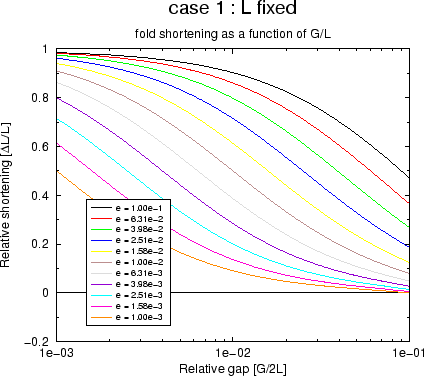Surface Distortion and Diminishing Area |

|

|

|

|
|
Surface Distortion and Diminishing Area |

|

|

|

|
The folding process introduces some distortion to initial geometry. The outer surface becomes "lengthened" and the inner surface becomes "shortened". It is useful to evaluate the influence of a fold on the airbag surface in order to avoid a situation wherein the airbag, after folding and inflating, is quite different from the original one.

Figure 30: Symbols used in formula for surface reduction.
As an introduction to some symbols (see Figure 30), let L be the width of the tilted part of the airbag, let G/2 be the half gap, and let E be the airbag's thickness.
There are two extreme cases to examine: In the first one, the airbag is not yet folded. In this case it is very thin and the value of L is known as it is supplied by you. The relative shortening (with respect to L) is found with the formula, ![]() where
where ![]() (relative thickness) and
(relative thickness) and ![]() (relative gap). It is assumed that there are only two layers of the airbag.
(relative gap). It is assumed that there are only two layers of the airbag.

Figure 31: The relative shortening of the folded part as a function of relative gap (for different relative thickness values - case 1.
Figure 31 shows the dependence of the shortening of the folded part on the relative gap for several relative thickness values. The conclusion in that case is that it is better to have a very thin airbag and give a possibly high gap value in order to have the smallest surface difference after folding.

Figure 32: The relative shortening of a layer as a function of relative distance from the mid-plane (for different ![]() values) - case 2.
values) - case 2.
In the second case, the airbag is thick and the value of L depends on gap, airbag's thickness, and the maximum ![]() value by the formula,
value by the formula, ![]() .
.
In this case, it is not possible to use the same formula with normalized variables because L is no longer a constant. But note that for a given ![]() value, the length increase of a layer distant of d from the symmetry plane (dot-dashed line on the Figure 30,
value, the length increase of a layer distant of d from the symmetry plane (dot-dashed line on the Figure 30, ![]() ) is a linear function of d (see also the Figure 32):
) is a linear function of d (see also the Figure 32): ![]()
The global effect of a fold on the airbag's surface will be null if this function is 0 at mid-distance between G/2 and ![]() , that is, at
, that is, at ![]() . This gives the following condition for the angle
. This gives the following condition for the angle ![]() :
: ![]() which can be transformed to (for
which can be transformed to (for ![]() ):
): ![]() .
.
As for actual airbags ![]() , this means that
, this means that ![]() , that is, the global shortening effect is small for angle
, that is, the global shortening effect is small for angle ![]() . Thus, the best value of the parameter
. Thus, the best value of the parameter ![]() is about
is about ![]() if the global surface of the airbag is to be maintained.
if the global surface of the airbag is to be maintained.
Figure 31 shows that in the first phase of folding, a shortening of the surface is very hard to avoid. It may be useful to choose the ![]() parameter larger than
parameter larger than ![]() in order to compensate for the surface shortening that occurred during the first phase of folding by a surface increase during the second phase (Figure 32).
in order to compensate for the surface shortening that occurred during the first phase of folding by a surface increase during the second phase (Figure 32).
To summarize what has been previously discussed in terms of choice of folding parameters values and initial geometry:
| • | The initial geometry of an unfolded airbag should be as thin as possible. The only limiting factor should be the Engine's interface performance. |
| • | The gap should be as large as possible. In practice, its value will be limited by the final airbag's thickness. |
| • | The L value has no effect on surface conservation. It is determined by the minimum time step condition. |
| • | The |